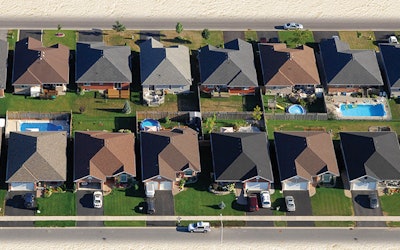
It's raining in California and that comes as welcome news for a state badly impacted by the recent historic drought. Unfortunately, no matter how much it rains and snows in the Golden State this year, it won't be enough to replenish reservoirs and aquifers that have been badly depleted over the past four years.
Through this drought and others in recent memory, the aquatics industry has learned the hard way that when the weather turns dry, recreational bodies of water are among the first targets for those seeking to restrict water usage. The perception that pools and spas are a decadent waste of water and should be among the first targets for restriction has become a familiar refrain, despite the fact that pools and spas account for only an infinitesimal percentage of urban water consumption.
That's certainly been the case in California where battles over draconian restrictions for filling or refilling pools have unfolded from North to South. In response, the CPSA, the industry's lobbying group in the state, has fought back with hard data to counter the perception of pools and spas as water wasters.
Now as an "El Niño year" starts to deliver much-needed rain, some are worried that the wet weather may lead industry professionals as well as consumers to wrongly conclude the drought is over and no longer an issue.
"That's a real concern," says John Norwood, president of CPSA. "For example, last year we had some rain early in the season and everyone thought we might be out of it and we all started to relax a little. But then it didn't rain for a long time, and once again, we were in a state of drought hysteria."
That hysteria prompted California Governor Jerry Brown to take the unprecedented step of requiring water reductions for every city in the state, a controversial move that critics believe has resulted in unfair pressure and penalties on residents, who in many cases are already saving water. And it's certainly lead many municipalities to target pools and spas.
"It was totally unanticipated and had never been done before," Norwood says. "In 2014, we targeted water districts. They were the ones creating the regulations. We felt pretty good about the work we had done there. We had interacted with the Association of California Water Agencies, the State Water Quality Control Board, the Governor's office and the Department of Water Resources. Those efforts resulted in the fact that there is no statewide restriction on potable water used in swimming pools and spas. We felt pretty good about what we had accomplished, but we did not anticipate what would happen in 2015."
Suddenly, with the governor's conservation mandates, the battleground shifted from Sacramento to individual cities, which are all required to implement water management plans and water conservation contingency plans, which vary from city to city. It was within those plans that pools and spas became targets for varying levels of restrictions.
A COMPELLING ARGUMENT
With 482 cities in 58 counties in California, each with its own plan for conservation compliance, the CPSA has had its hands full. Still, the Association has battled regulators with remarkable success.
"So far, we've engaged in excess of 90 cities," Norwood says. "We developed a system for monitoring what's on city agendas and now we're alerted when a city is considering a restriction. Usually we only have 48 hours to respond and sometimes only 24 hours. We have recipe for what we're doing with each of these cities and we've been wildly successful. When they see the numbers and realize that pools use very little water, we're able to convince them to move the restrictions back to later stages or in some cases eliminate restrictions altogether."
In what may come as a surprise to some, the "recipe" CPSA has used does not focus on the familiar refrain that pools and spas require the same or less water as grass areas of the same size. Instead, CPSA has developed a persuasive argument based on the percentage of water new pools use in a given local. Those calculations are based on an average size pool and a conservative estimate for surrounding decks and hardscape, which of course use no water. The amount of water consumed is then compared to the total amount of water used annually in a given municipality.
"It always comes out to a fraction of a percent," explains Norwood, "We did that for statewide usage and it comes out to a 1,000th of a percent. The story is that pools use comparatively very little water. If you're going to shut us down, you're going to have to shut down other things like car washes, for example.
"The lawn comparison is comfortable and familiar," he adds, "but we moved beyond that to look at how much water pools really use. Basically the pool with decking will use about the same as drought-resistant landscaping. If you use a cover, the numbers are even more favorable."
NATIONWIDE CONCERN
While CPSA is fighting the industry's battles in California, concerns over drought-related challenges are gaining national attention. For example, in a recent step to help pool professionals throughout the country deal with draining restrictions and resulting water-quality issues, APSP's Recreational Water Quality Committee last November released a position paper outlining the issues stemming from "aging water," a term that refers to the buildup of contaminants of all types in water over time, from calcium to bather waste.
When water is cheap and plentiful, aging water is simply replaced. But when regulations prevent draining and refilling, a difficult problem arises.
The RWQ Committee's position paper, titled "Drought Concerns: What to Do When Water Conservation Measures Cause Water Parameters to Exceed Recommended Limits" addresses a range of potential problems with an eye toward possible remedies.
"We were inundated with calls from people that didn't know what to do because they were prohibited from draining the pool," explains committee member Greg Garret. "Because of those concerns, we made it a priority and went to work on the position paper. It covers the various issues you have to be cognizant of when you have pool that has aging water. In some cases you have severe aging."
To be sure, many of the issues and recommendations covered in the paper are familiar to professionals who have studied water treatment, but it goes much further by addressing issues of sanitation, water testing and maintaining mineral balance in the context of draining restrictions. "Basically, the RWQ Committee is set up to be sure the industry is doing what we can to make the best use of this precious resource water," says Carvin DiGiovanni, APSP's senior director, technical and standards. "Without water available for pools and spas, we don't have an industry. That's why we're looking at the drought scenario and the bigger picture as well."
FRESH TAKES
In addition to looking at familiar issues with fresh eyes, the paper also covers areas that are new to many within the industry, such as the use of various membrane filtration methods to lower TDS and potentially problematic chemical constituents, such as disinfection by-products (or DBPs).
"Membranes remove inorganic compounds, organic compounds, and particulate matter by creating a barrier through which water is preferentially passed. While both reverse osmosis (RO) and nanofitration (NF) membranes are able to filter out both DBP precursors and DBPs, the increased flow rates and decreased pressures associated with NF membranes make them more economical than RO membranes. The greatest limitation of membrane technology is the tendency of the membrane to foul and lose efficiency when they bind microorganisms, colloidal or particulate matter, dissolved organic compounds, and slightly soluble inorganic compounds."
While various filtration methods can offer some help, the committee also pulls no punches in pointing out the potential drawbacks: "It is also important to note that RO and NF are far less than 100 percent efficient. With common RO systems, for instance, 20 to 25 percent of the treated water is lost as a 'retentate,' in which the impurities are concentrated. This water would need to be discharged, with possible regulatory hurdles. In addition, a comparable amount of makeup water would have to be added to the pool."
Another potentially helpful measure, which may still be unfamiliar to some, is the use of alternative sanitizing technologies to minimize chemical use, thus inhibiting TDS buildup and the formation of DBPs. The authors write: "Use of ozone or UV, may enable the pool operator to reduce chemical usage. In principle this could also result in less formation of disinfection byproducts and less accumulation of TDS."
BROADER PERSPECTIVES
According the Garret, the value of the paper stems from the fact that it is based entirely on accepted science and recommended industry practice: "The standards exist for a reason," he says. "We know there are issues associated with aging water, and when those levels far exceed the standards, they start to impact other things, from equipment to plaster to grout and many others."
Both in California and nationwide, there's both a sense of immediate urgency accompanied by the longer view that in the future, the industry must always be prepared to address drought-related issues, whenever and wherever they arise.
"The committee is doing their part in addressing drought scenarios," says DiGiovanni. "We certainly hope for input and other useful information going forward, but this is a great start. The last thing we want to see are restrictions on water used in pools and spas. That's why it's important we're stepping forward as an industry to be sure we're not closed out of those conversations. We want to establish our seat at the table when those discussions arise, and we want to establish in the minds of the consumer that we're making responsible use of water."
Back in California, Norwood is understandably proud of the CPSA's record defending the industry's interests, yet he also expresses frustration about complacent industry members who have remained on the sidelines: "The people who become involved and support our efforts have done a great job," he says. "But it's a very small group of people. There are many in our industry who leave it to someone else to fight their battles and as a result industry support has been woefully inadequate. Going forward, if we're going to be successful fighting these battles, we need the help of far more people in the industry. It's one thing when a lobbyist represents the industry, it's quite another when a business owner shows up to a meeting.
"And that," he says, "holds true whether it's raining or not."
Comments or thoughts on this article? Please e-mail [email protected].

































![IPSSA’s incoming President Michael Denham [left], Rose Smoot, IPSSA Executive Director [center] and the outgoing President, Todd Starner [right].](https://img.aquamagazine.com/files/base/abmedia/all/image/2024/04/New_IncomingPres_MikeDenham_RoseSmoot_outgoing_president_ToddStarner_IMG_3920_copy.662682e0cbd3a.png?auto=format%2Ccompress&fit=crop&h=112&q=70&rect=0%2C345%2C3024%2C1701&w=112)




